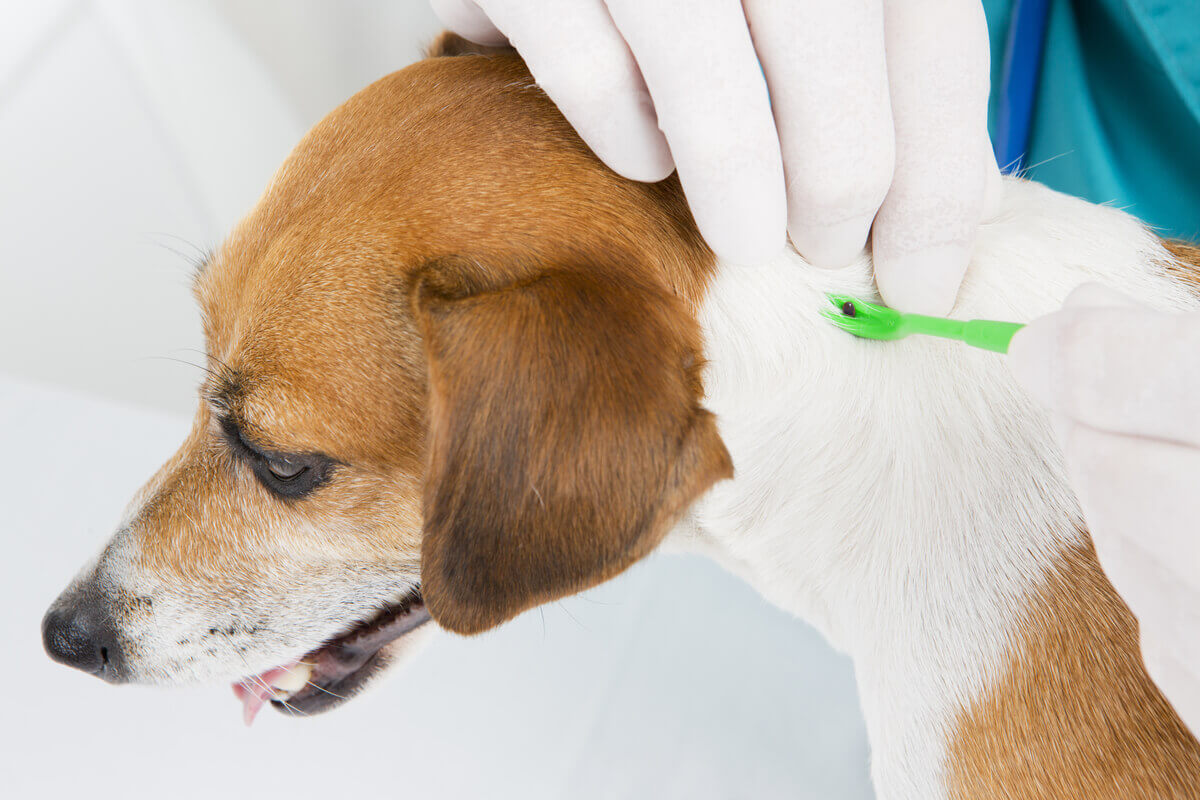How to Treat Insect Bites and Stings in Dogs

As spring and summer approach, there’s a fear among pet owners regarding insects and their dogs. This is because, during these seasons, various invertebrates are more active than ever. Any dog or other animal is at risk of being stung or bitten. Therefore, it’s important to know how to treat insect bites and bee stings in dogs.
How to deal with dog bites?
Dogs are extremely curious, which can get them into some sticky predicaments at times. One of these situations can be an encounter with an insect.
Insects won’t ever understand the curiosity of dogs. And, if they feel threatened, they’ll attack. In the end, you’ll find your dog with a swollen area, scratching itself nonstop.
When this happens, first of all, you need to remain calm but alert. Normally, this type of experience is nothing more than a scare. However, it’s always a good idea to keep an eye on your dog in case there are complications.

What insects can attack dogs?
Perhaps the first invertebrates that come to mind are wasps and bees. However, they’re not the only insects that dogs encounter. Other insects that can cause bites in dogs include flies and mosquitoes. At the same time, they can also fall victim to spiders.
There are other more dangerous candidates, such as fleas or ticks. The bites of these two insects are dangerous because symptoms can become more complicated.
Flea bites are characterized by a slight swelling of the area as well as itching. If the dog is allergic to the bite, the itching can be so intense that it causes complications, such as skin infections.
On the other hand, ticks are vectors that transmit different diseases such as Lyme disease. In this case, it’s not the swelling of the bite that should be of concern, but the possible transmission of diseases.
How to treat insect bites and stings in dogs
When you notice your dog got stung or bitten (and that it’s not serious), you should follow the advice below.
Ice to combat swelling
It won’t be easy to apply ice wrapped in a handkerchief to the dog that has received the bite. However, this technique is one of the most commonly used to combat itching.
This is because applying cold will help decongest the area. Therefore, it will help to keep itching under control and help calm your animal down.
Wash with water and soap
One of the risks of stings is that an infection may develop in the area. Therefore, it’s advisable to wash the affected area with plenty of soap and water. It’s also essential to be careful to rinse the area thoroughly to remove all of the soap.
Watching your dog
It’s important to keep an eye on your dog in case it develops any symptoms that could be a sign of complications. If the dog gets worse, a visit to the vet is mandatory.
Although normally an insect bite simply causes a slight swelling and itching, this is not always the case. In some cases, the itching can get worse and last for weeks.
In the worst of cases, animals can go into anaphylactic shock, which is a very severe reaction to the sting. In the case of anaphylaxis, your pet will require emergency attention in order to apply effective treatment.
There’s a variety of symptoms that can indicate anaphylaxis in dogs. These include vomiting, diarrhea, urticaria, excessive itching, and breathing difficulties. Other symptoms can be unconsciousness or lethargy as well as the opposite effect, hyperactivity accompanied by tachycardia.
How to identify the severity of stings in dogs?
Insect stings usually don’t produce complications in dogs, but there’s always some risk. The risk factors include the site of the sting since it’s a sting to the leg is much different than a sting in the throat or inside the mouth.
If the insect has stung the animal in the throat or inside the mouth, this is a serious situation. Only a veterinarian knows how to act correctly in these cases since, if the insect has injected venom, it can cause allergic reactions.
In addition, if the dog is allergic to the sting or bite of a specific insect, you’ll need to have an emergency kit. In it, there’ll be an injection to fight the allergic reaction. Even so, it’s crucial that you take the dog to the veterinarian for a thorough evaluation.
Another important risk is the number of stings that can occur. The higher this number is, the more complicated the symptomatology and treatment will be.

In short, it’s important to be attentive and know how to treat insect bites and stings in dogs. Keep in mind that you should never resort to homemade remedies that can make the situation even worse than it is.
The advice and attention of a veterinarian in these cases is indispensable to avoid complications. For that reason, always go to an expert who knows how to confront the situation, since each animal can react in a different way.
As spring and summer approach, there’s a fear among pet owners regarding insects and their dogs. This is because, during these seasons, various invertebrates are more active than ever. Any dog or other animal is at risk of being stung or bitten. Therefore, it’s important to know how to treat insect bites and bee stings in dogs.
How to deal with dog bites?
Dogs are extremely curious, which can get them into some sticky predicaments at times. One of these situations can be an encounter with an insect.
Insects won’t ever understand the curiosity of dogs. And, if they feel threatened, they’ll attack. In the end, you’ll find your dog with a swollen area, scratching itself nonstop.
When this happens, first of all, you need to remain calm but alert. Normally, this type of experience is nothing more than a scare. However, it’s always a good idea to keep an eye on your dog in case there are complications.

What insects can attack dogs?
Perhaps the first invertebrates that come to mind are wasps and bees. However, they’re not the only insects that dogs encounter. Other insects that can cause bites in dogs include flies and mosquitoes. At the same time, they can also fall victim to spiders.
There are other more dangerous candidates, such as fleas or ticks. The bites of these two insects are dangerous because symptoms can become more complicated.
Flea bites are characterized by a slight swelling of the area as well as itching. If the dog is allergic to the bite, the itching can be so intense that it causes complications, such as skin infections.
On the other hand, ticks are vectors that transmit different diseases such as Lyme disease. In this case, it’s not the swelling of the bite that should be of concern, but the possible transmission of diseases.
How to treat insect bites and stings in dogs
When you notice your dog got stung or bitten (and that it’s not serious), you should follow the advice below.
Ice to combat swelling
It won’t be easy to apply ice wrapped in a handkerchief to the dog that has received the bite. However, this technique is one of the most commonly used to combat itching.
This is because applying cold will help decongest the area. Therefore, it will help to keep itching under control and help calm your animal down.
Wash with water and soap
One of the risks of stings is that an infection may develop in the area. Therefore, it’s advisable to wash the affected area with plenty of soap and water. It’s also essential to be careful to rinse the area thoroughly to remove all of the soap.
Watching your dog
It’s important to keep an eye on your dog in case it develops any symptoms that could be a sign of complications. If the dog gets worse, a visit to the vet is mandatory.
Although normally an insect bite simply causes a slight swelling and itching, this is not always the case. In some cases, the itching can get worse and last for weeks.
In the worst of cases, animals can go into anaphylactic shock, which is a very severe reaction to the sting. In the case of anaphylaxis, your pet will require emergency attention in order to apply effective treatment.
There’s a variety of symptoms that can indicate anaphylaxis in dogs. These include vomiting, diarrhea, urticaria, excessive itching, and breathing difficulties. Other symptoms can be unconsciousness or lethargy as well as the opposite effect, hyperactivity accompanied by tachycardia.
How to identify the severity of stings in dogs?
Insect stings usually don’t produce complications in dogs, but there’s always some risk. The risk factors include the site of the sting since it’s a sting to the leg is much different than a sting in the throat or inside the mouth.
If the insect has stung the animal in the throat or inside the mouth, this is a serious situation. Only a veterinarian knows how to act correctly in these cases since, if the insect has injected venom, it can cause allergic reactions.
In addition, if the dog is allergic to the sting or bite of a specific insect, you’ll need to have an emergency kit. In it, there’ll be an injection to fight the allergic reaction. Even so, it’s crucial that you take the dog to the veterinarian for a thorough evaluation.
Another important risk is the number of stings that can occur. The higher this number is, the more complicated the symptomatology and treatment will be.

In short, it’s important to be attentive and know how to treat insect bites and stings in dogs. Keep in mind that you should never resort to homemade remedies that can make the situation even worse than it is.
The advice and attention of a veterinarian in these cases is indispensable to avoid complications. For that reason, always go to an expert who knows how to confront the situation, since each animal can react in a different way.
All cited sources were thoroughly reviewed by our team to ensure their quality, reliability, currency, and validity. The bibliography of this article was considered reliable and of academic or scientific accuracy.
-
Francisco CS. Las picaduras de insectos en el perro | Clínica Veterinaria San Francisco [Internet]. [citado 11 de julio de 2020]. Disponible en: https://clinicaveterinariasanfrancisco.com/las-picaduras-de-insectos-en-el-perro/
-
Picadura de avispa en perro, ¿cómo actuar? [Internet]. Advance. 2020 [citado 11 de julio de 2020]. Disponible en: https://www.affinity-petcare.com/advance/es/perro/picadura-de-avispa-en-perro-como-actuar
This text is provided for informational purposes only and does not replace consultation with a professional. If in doubt, consult your specialist.








